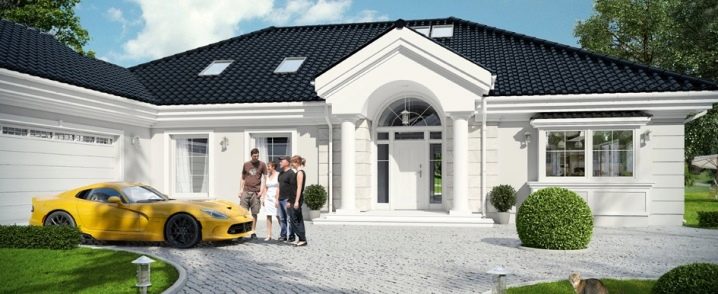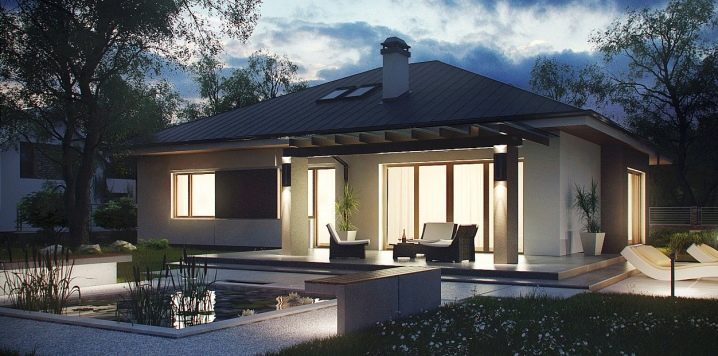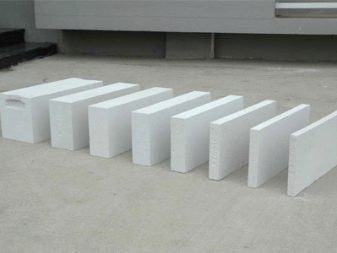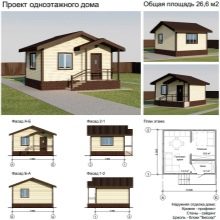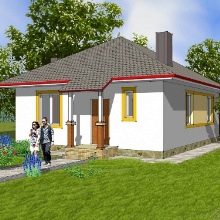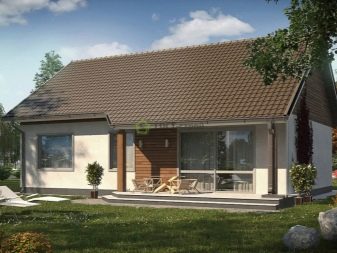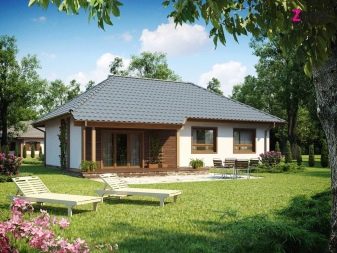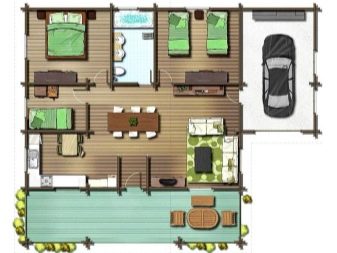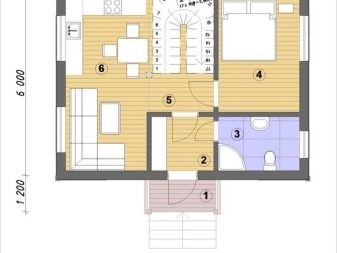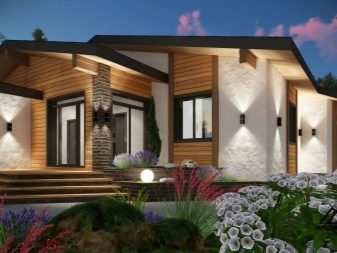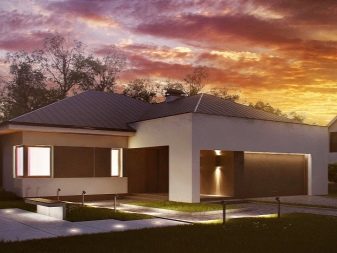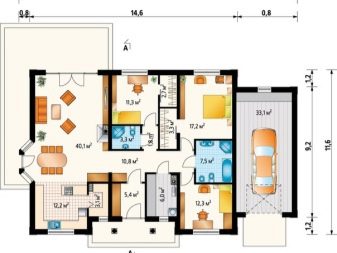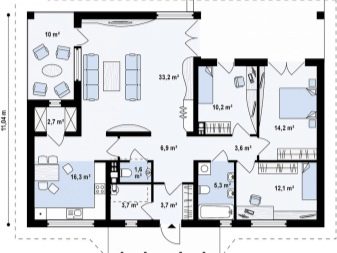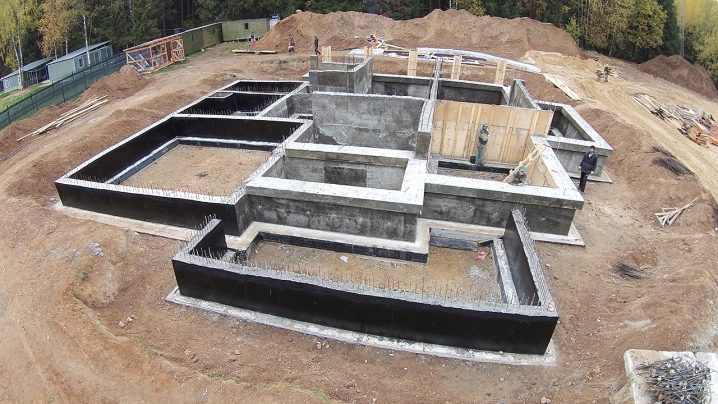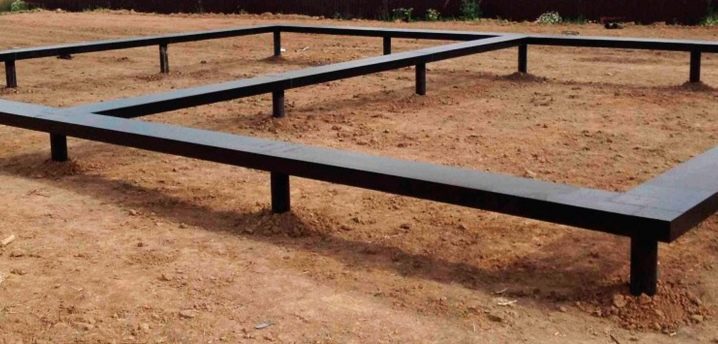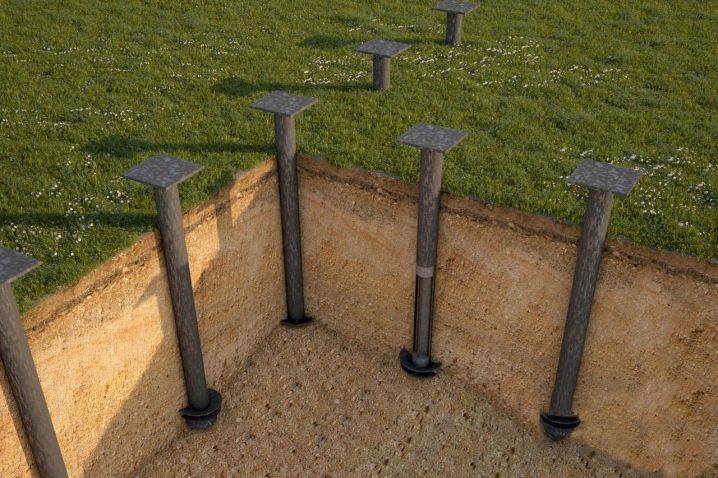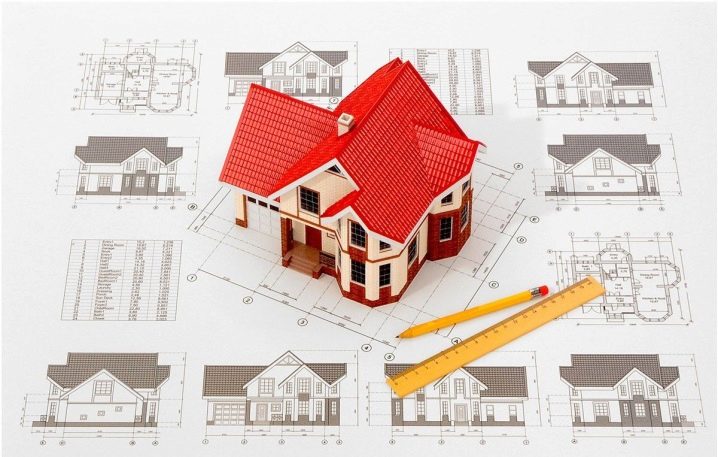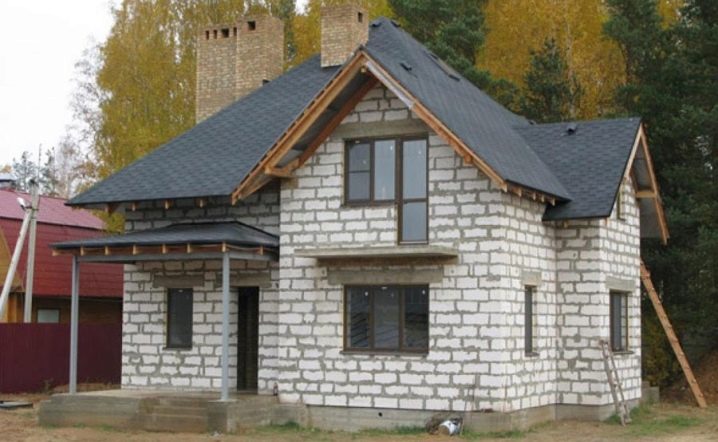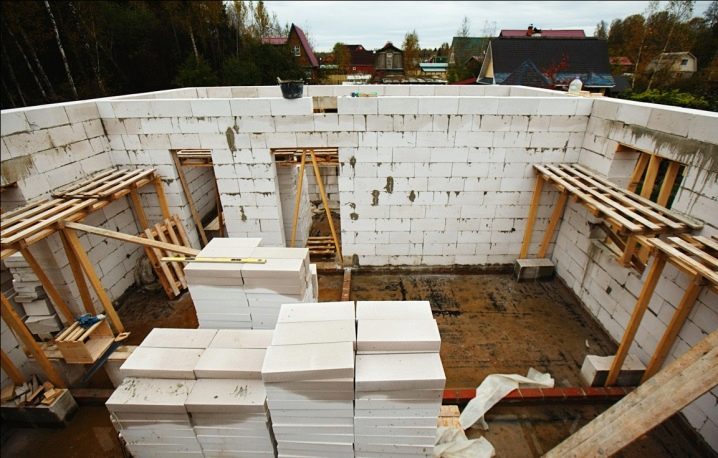Beautiful projects of one-story houses of aerated concrete
Houses from gazoblokov today - one of the most popular options for country building. They are suitable for permanent residence, and for the summer - as a problem. Such a wide distribution is easy to explain - aerated concrete is inexpensive, easy to use, and at the same time it has good thermal insulation quality.
It is possible to build both a one-story and a two-story house from a gas-block, and even a “one-and-a-half” house with an attic. In the aerated concrete houses at the request of the owner will accommodate a sauna, garage and / or basement.
Design features
Aerated concrete is called light cellular concrete. It is obtained from a mixture of cement or lime, silica sand, aluminum powder and water. The chemical reaction, in which aluminum powder and lime enter, causes the evolution of gases, due to which a porous structure is created inside the block, distributed in equal proportions.
Because of their porous structure, aerated concrete blocks have the following properties:
- good thermal insulation;
- low flammability and high fire resistance - 70 minutes;
- excellent sound insulation;
- frost resistance - from 50 to 100 cycles;
- the accumulation and preservation of heat, thereby maintaining a constant air temperature in the house;
- saving material and mortar for laying due to the flat and smooth surface of the gas blocks;
- long service life - up to 100 years;
- easy material handling.
As well as projects from other building materials, houses from aerated concrete are divided into buildings of economy, middle and business class.
The first group includes the most low-cost options for construction. As a rule, in this situation we are not talking about the second floor, the maximum that fits into the budget is the attic.
The area of such buildings is about 20-30 square meters. meters Accordingly, on a large summer cottage such a house can become a guest house, along with the “capital” house in which the owners live. If the site is small, and the budget is limited, the construction of aerated concrete may well become a dacha where the owners will spend the summer without any problems.
On average, the cost of such structures ranges from 300 to 400 thousand rubles.
Attic, although not considered a full floor, can significantly expand the area of the house. Most often it is in it that they have a bedroom, which makes it possible to make the living room downstairs, combined with a kitchen unit, a spacious bathroom and a hall. At the same time for the construction of the attic does not require as much cost as for the construction of the second floor, do not need a reinforced foundation.
The projects of aerated concrete houses of the middle class (with one floor and no attic) are being developed with an area not exceeding 50 sq. M. meters Regardless of whether there is an attic or not, the cost of the project will be about 900 thousand rubles.
Again, if there is an attic, it is possible to move the master bedroom and children's room into it (if there are children in the family).
As for the ground floor, since the area is quite large, we can consider two options for the use of space:
- two or three large rooms (living room, kitchen-dining room and room at the request of the owners - a billiard room, a gym, a study);
- four to five small rooms.
If you plan to live in the house permanently, it is necessary to provide a technical room (boiler room).
It should not be forgotten that a veranda can be attached to the house and a dining room can be brought into it. What could be nicer than drinking a cup of tea, looking at a blooming garden?
As for business-class aerated concrete houses, these projects are unusually comfortable, these are full-fledged cottages. Their cost is from two million rubles and more, and the area is at least 80-90 square meters. m
Luxury cottages include spacious rooms:
- bedrooms;
- the kitchen;
- separate dining room;
- auxiliary facilities block (boiler room, storeroom);
- a living room, possibly with a bay window;
- wardrobe;
- cabinet;
- bathrooms and toilets, possibly with a sauna;
- ground floor with standard ceiling height;
- additional rooms, depending on the owner's wishes, a garage for one or two cars, a heated veranda, a greenhouse with a winter garden.
An outdoor summer terrace with a barbecue area can be attached to the house. In short, the flight of the owner’s imagination can be limited only by his budget. The rest - there are no obstacles in order to build the cottage of your dreams from aerated concrete blocks.
This material allows you to build houses of all the listed comfort classes in the southern regions, and in the middle lane, and in the north. Aerated concrete is compatible with any type of heating - stove, fireplace, boiler.
In addition, it is strong enough to build two-story houses from it. That is why it is so widely used in the construction of country houses.
Choosing a foundation
Compared with other building materials aerated concrete blocks are easy. It is for this reason that houses of aerated concrete do not require the construction of a complex and expensive foundation. The only condition is that the foundation must be correctly calculated. Since the wall of aerated concrete blocks is a rigid, non-plastic construction, if the foundation is squeezed, it will crack.
The type of foundation will be determined by analyzing the quality of the soil and the parameters of the house itself. Small-scale houses are built from aerated concrete - up to 3.
The most suitable foundation types for such buildings are:
- tape
- monolith;
- piles;
- columnar.
The most expensive of the above will be the first and second. They require a large amount of both reinforcement and concrete, and this entails costs for both finance and construction time.
Therefore, if you do not want to invest a large amount of labor and financial resources in the construction of the foundation, it is better to focus on the column-ribbon version. This will help save on stoves at the base of your home.
However, there are situations where only a tape base can be used to build a house. For example, if the ground is sandy, heaving and prone to shifts. Also, the tape foundation is needed where the laying of the base is assumed to be shallow - from 60 cm.
A monolithic foundation is usually laid where groundwater is located high to the surface. Slab bases are divided into rib and endless.
If there are no stiffeners on the slabs, its strength level decreases, and such a foundation can be used for a small structure - a storeroom or a shed. For larger-scale structures, it is better to take a monolithic slab of shallow depth with reinforcing ribs.
Its properties are as follows:
- when the soil freezes, preserves integrity, not sagging or cracking;
- high bearing capacity;
- resistant to deformation when moving ground.
These properties of the monolithic foundation will allow to build on it not only one-, but two- and three-storey house from aerated concrete blocks. But we must bear in mind that this type of base does not allow the equipment of the basement, in addition, it is not budget.
Pile and column foundations are much more economical options, since the material consumption is much less, it is easier to build, and both are suitable for difficult soils.
Installation of both piles and pillars is carried out along the perimeter of the building in a dotted way. Recesses for the pillars are prepared in advance.
Further, that the pillars, that the piles on top are connected by a grillage - a reinforced concrete integral horizontal frame. Functions of the grillage - in the uniform distribution of the load on the piles / posts and combining them into a seamless structure. On the grillage and the construction of the house.
If the soil is weak, frozen, heaving or flooded, the pile foundation can also be used, but the piles must be of a special type - screw. Then you do not even need to level the land.
The advantages of the pile and column foundations are:
- the ability to put them at any time of the year;
- the draft of the house on such a ground is smaller and occurs evenly
- the grillage enhances the stability of the structure.
Ribbon foundation is better suited for two-or three-storey houses.
It is undesirable to take aerated concrete blocks for the foundation of the house, since this material is rather fragile and not waterproof, ground water will easily destroy it.FBS (fundamental block of solid) weighing about 3 centners is suitable for strip foundations.
The tape base with shallow deepening is suitable for houses without a basement. If a basement is needed, then the base will need to be recessed, with a standard depth of about 150 cm. As a general rule, the trench should be placed 20 cm deeper than the level of soil freezing.
The width of the trench is calculated in each case individually and depends on how much the building weighs. Wall thickness is another parameter that must be considered when calculating the foundation. Therefore, the width of the base should exceed the width of the wall by 10 cm. The wall is located in the middle of the trench, and 5 cm of trench remains on each side of it.
To find out the bearing capacity of the soil in the region in which the construction is underway, you can contact both the Internet and the specialists of the design workshop. If you know what type of soil where the construction is planned, it is easy to find out.
Blueprints
The project of a one-story house of aerated concrete can, if you have some skills, develop yourself or ask for help from the relevant specialists.
If you are planning to build an economy or middle class building with an area of 8 by 10, the calculation and drawing can be developed alone.
In the case when you "swung" on a 10x10 luxury cottage with an area of 100 sq. M. meters or even more - 150 square meters. meters, it is better to help you professionals. Since the house of such an area is not cheap, you should not try to save on its project, because this is the plan on the basis of which your dream will be fulfilled.
In accordance with current regulations, a house of aerated concrete blocks with a height of “one” should be erected as follows:
- wall blocks should be used in conditions in which the humidity does not exceed 75%;
- external walls should have a frost resistance grade - F25 or higher, and for rooms with high humidity - not lower than F;
- vertical and horizontal seams should not be thicker than 1-2 mm;
- adhesive solution used for masonry walls should have a water holding capacity of at least 98%, as well as compressive strength - 10 MPa;
- load-bearing exterior walls should have a recommended width of 600 mm, and self-supporting ones - from 300 and above;
- metal elements used in construction are made of stainless or anodized steel;
- Floor slabs on the basement or second floor should have a depth of abutment from 120 to 150 mm.
Tips
Often a person, having met the announcement “houses from turnkey gas blocks” and seeing that the cost is low, is happy and believes that a way out has been found. But this is not always the case, especially in cases where poor-quality material is used for the construction of such houses.
In most cases, such companies manufacture aerated concrete blocks themselves, not complying with the production technology. The material turns out to be inconsistent with the requirements for aerated concrete, and often even unhealthy.
Handicraft production conditions reduce the cost of material, but this apparent savings can result in costly repairs.
Therefore, first of all, you need to be interested in the quality of the material, the presence of certificates of compliance with GOST, as well as what documents the developer has.
One of the projects of a single-story house with an attic of aerated concrete, see the following video.
